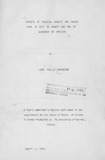| dc.description.abstract | In the studies of stocking densities and growth, the starter chicks showed average total body weight gains of 545.73, 523.33 and 513 grams when housed at 465; 372 and 279 cm2/chick respectively. In the finisher phase and in week 8 of age, broilers showed weekly body weight gains of 138.18, 236.38 and 142.7 grams per chick when housed at 930, 744 and 558 cm2/bird respectively.
In the subsequent studies with high energy diets and high stocking densities, the average body weight gain increased by 27.7 percent with an increase in dietary energy level from
2,700 to 3,000 kcal/kg of feed. Body weight gain decreased by 4.9 percent as floor space allowed per bird decreased from 300 to 240 cm2/chick. In the finisher phase dietary
energy levels of 2,930 and 3,200 kcal/kg of feed did not significantly affect average body weight gain. Similarly floor space allowances of 465 and 558 cm2/bird did not affect average body weight grain. Dietary energy levels significantly affected the overall 0 to 8 weeks average body weight. The broilers on high dietary energy level were 22 percent heavier than broilers on low dietary energy level. A 4 percent decrease in average body weight was observed as floor space allowed per bird decreased from 558 to 465 cm2/bird. In both studies high stocking densities were associated with more total body weight and body weight gain per unit of floor space.
The high average body weight gain of birds housed at 465 cm2/chick during the starter phase and 744 cm2/bird during the finisher phase in the first study were attributed
to higher feed utilization efficiency. In the starter and finisher phases of the second study, the higher body weight gain and total average body weight were due to the higher feed efficiency on the high dietary energy level. The low stocking densities allowed for high feed intake.
These studies show that feed was utilised efficiently at the low and middle stocking densities at the starter and finisher phases respectively and that at high dietary energy
level broilers grew just as well when housed at high stocking densities as when housed at the low and middle densities at the starter and finisher phases respectively of the first
study. | en |

